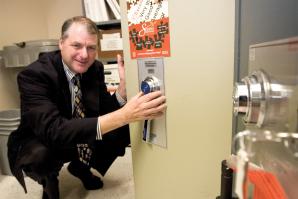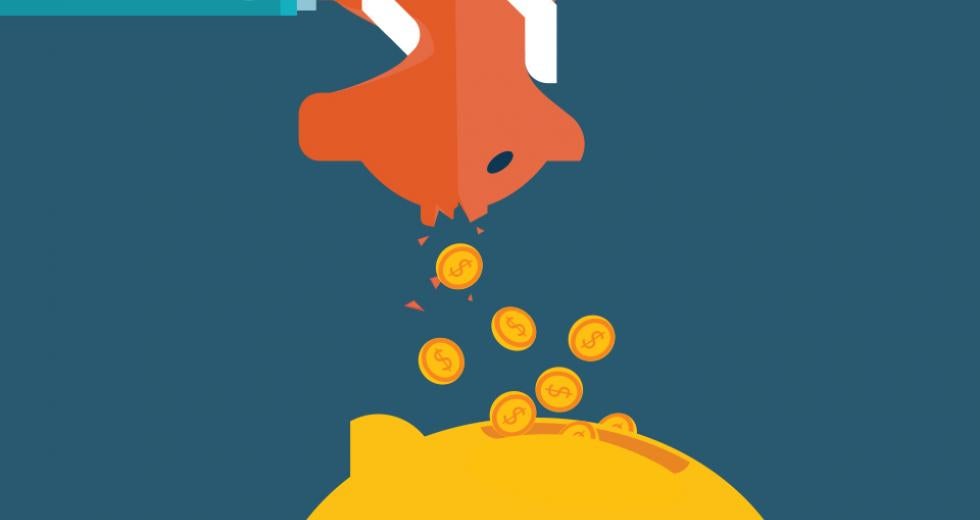On a hot, sunny morning last fall, 69-year-old retiree Pamela Chappell of Citrus Heights hit rock bottom. She was scraping by on Social Security checks and a tiny pension while paying for medication to treat her lymphedema, a painful swelling in her legs. Then she got a letter from the IRS warning her that it was about to empty her savings account of $8,000 — every dollar she had — for back taxes. When Chappell called to plead, the agent said she’d hang up if Chappell didn’t stop crying. “Life wasn’t worth living anymore,” Chappell says.
Not knowing where to turn, she drove to Big Valley Federal Credit Union, where she’d been a member for 40 years; it was a place she’d always felt comfortable. She sat in her car for an hour, stewing over where to go for money. “A million things were going through my head. I had so many crazy thoughts,” she says. Finally a teller recognized her and came out to see what was the matter. “Why don’t you come wait inside?” she said.
She took Chappell to see CEO Linda Sweet, who gave her a glass of water, put her in a recliner in the breakroom and listened to her story. “We’ll get through and talk to them and see what’s going on,” Sweet told Chappell. And together they called the IRS. After some discussion, Sweet and an IRS agent worked out a plan. Chappell would repay just $800 in installments of $25 a month. She could keep the money in her account.
While the 100 biggest credit unions represent only 1.4 percent of the industry, they contribute half of the asset growth and about 90 percent of its member growth.
The Financial Brand
“If she’d have gone anywhere else, to a big financial institution, I don’t know what would have happened to her,” Sweet says. Individual attention makes small credit unions essential, she says. But today’s low-interest-rate environment, new federal regulations and consumer demands for more online banking options are steadily eroding their ability to stay afloat, say credit union industry experts and insiders.
Half of Credit Unions May Go Under
The credit union industry as a whole is booming. Last year it added a record 2.4 million members nationwide. Today, nearly 40 percent of American adults belong to a credit union.
But almost all those gains can be attributed to a smattering of the largest credit unions. While the 100 biggest credit unions represent only 1.4 percent of the industry, they contribute half of the asset growth and about 90 percent of its member growth, according to banking industry trade journal The Financial Brand.
Meanwhile, the number of small credit unions, those with less than $100 million in assets, is shriveling over time. Every month, about 20 small credit unions are lost to mergers and closures. According to The Financial Brand forecasts, half of all credit unions will disappear by 2032 if trends continue at current pace.
Locally, at least two small credit unions have survived only by merging in recent years with larger institutions. In August 2011, following heavy losses, the $20-million Sacramento District Postal Employees Credit Union merged into the larger Southern California Postal Credit Union of Long Beach. And in January, the small 49er Credit Union of Placerville merged into Yuba City-based Sierra Central Credit Union after posting a loss in 2013.
New Rules, More Demands
Credit unions and banks alike have complained about outsized costs associated with new regulations ushered in by the 2010 Dodd-Frank Wall Street Reform and Consumer Protection Act.
For example, new federal regulations that govern mortgage lending went into effect in January; they’re designed to ensure that borrowers can actually afford to pay back their mortgages. But just understanding those rules is straining small credit unions. Frank Michael, CEO of $22-million Allied Credit Union in Stockton, says the “simplified” version of the rules ran 1,000 pages. Staying on top of those and other changing regulations stretches small credit unions to the breaking point, since they often have only one or two full-time employees dedicated to compliance issues, Sweet told a U.S. House of Representatives subcommittee last December.
At $700-million Sierra Central, the number of man-hours dedicated to keeping up with regulations has shot up 20 percent since the law went into effect, according to CEO John Cassidy. A 2011 survey by the National Association of Federal Credit Unions, an industry trade group, found that 96 percent of them reported spending more time and money to stay on top of regulations that year than they did in 2009.
More than a quarter of credit unions have hired new staff to handle compliance since 2012, according to a March 2013 NAFCU survey.
The lending environment also has hammered small lenders. Low interest rates mean the difference between the interest rates they charge on loans and pay on deposits has shrunk, and for many it’s no longer enough to cover costs. “Raising fees is about the only thing left,” says Marvin Umholtz, an industry consultant. That’s tough, he adds, because credit unions historically used low fees to attract new members.
Meantime, consumer demands for more and better online and mobile banking options have layered on costs for small institutions, says Mike Schenk of the Credit Union National Association, another industry trade group. That’s because new online options don’t replace telephone and in-branch banking. Many customers still want to talk to someone in person, especially when they’re dealing with more complex financial transactions like getting a loan.
Employer-based credit unions have suffered as industries downsize, says Diana Dykstra of the California Credit Union League. Indeed, contraction in the newspaper industry has hit Sacramento-based McClatchy Credit Union hard, says executive manager Stephen Serfozo. His membership is down 40 percent since 2007.
As Big Credit Unions Win, Will the Industry Lose?
To be sure, consolidation is hardly confined to credit unions. The number of banks throughout the U.S. dropped below 7,000 last year, down from almost 18,000 in 1984. Nearly all of that decline can be attributed to mergers and failures involving small banks. “When Walmart comes to town, the local pharmacist gets squeezed out,” says Schenk. “From an economic perspective, these small institutions simply don’t have the economies of scale and scope to compete as effectively as they did 20 or 30 years ago.”
But small credit unions meet needs that other institutions cannot, say their advocates. They serve demographics — low-income people or specific ethnicities, for example — that sometimes go unserved by banks, says Dykstra.
The industry’s political clout also could suffer if small credit unions die. “If you have a thousand credit unions with six board members each, that’s 6,000 advocates,” says Fred Gomes of Provident Credit Union in Redwood City, which absorbed the small Alameda Credit Union in a merger last October. Fewer credit unions means fewer advocates talking to their members of Congress.
That could be especially important because as big credit unions expand further, they could become more inviting targets for the banking industry’s longtime campaign to strip credit unions of their nonprofit status. The American Bankers Association has published several briefs arguing that big credit unions are a “new breed” and have an unfair advantage. They offer products and services identical to big banks and have traveled far afield from the small nonprofits they began as in the Great Depression, but still they pay no taxes, argues the ABA. (A case study in one of the reports targets Sacramento’s $8-billion Golden 1 Credit Union.)
To be sure, credit unions play by some different rules than banks. They’re subject to a cap on commercial loans, have to abide by a federal rule that allows them to charge no more than 18 percent on loans and, unlike banks, have members, not shareholders, each of whom has a vote in how the credit union is run. Still, the ABA and the Independent Community Bankers of America wrote a letter in March to Representative Dave Camp (R-Michigan), chair of the U.S. House Committee on Ways and Means, urging Congress to end the “credit union tax subsidy — especially for large, complex credit unions.”
Collaboration Versus Consolidation
If small credit unions are to have a chance, say industry insiders, they’ll have to take cooperation to the next level. To that end, Serfozo and Sweet are part of a group of four CEOs from small Sacramento-area credit unions who meet monthly for lunch to figure out how they can help one another. When one of them was looking for capital to fund additional loans not long ago, Serfozo, always on the lookout for solid investments for his members, solved both problems by providing the necessary capital.
Another group of 57 mostly small and mid-sized Northern California credit unions meets every few months to discuss how they can cut costs collaboratively by working together to obtain reduced prices on marketing materials or printing, for example. Further south, three credit unions in Downey, El Segundo and Torrance have hired a single CEO, which Schenk says has saved them a bundle on staffing costs.
Collaboration like that isn’t found many places but may be one of the last tools small credit unions have left to survive.
“To a great degree, we’re serving the same people,” says Serfozo of the Sacramento CEOs. “But it doesn’t matter because we’re in it for one another, for the health of the industry.”
Chappell says she’ll be impacted if small credit unions go away. She’s on track with her payments to the IRS and bought Sweet a blanket as a gift to show her thanks. “They’re so important,” she says of Big Valley. “You know you can talk to them, and they’ll listen.”
Recommended For You

Cashing Out
Life among the ranks of the unbanked
Two hundred, four hundred … twenty, forty, sixty, eighty, five hundred …
As the young woman behind the glass divider counts out the entirety of my paycheck, I can’t help but think of how measly it looks before I stuff it in my wallet.

Where Credit’s Due
Lifing the lending cap on credit unions
If lawmakers follow through on pending legislation in Washington, it could mean a boost for business for Capital Region credit unions.




Comments
Taxes are a necessary evil to support our great society.I wonder if the irs is just as aggressive with the "top 1%"as they are in pursuing citizens that are not as wealthy....when was the last time you saw a credit union"too big to fail"...? That's where I keep my coin!!!